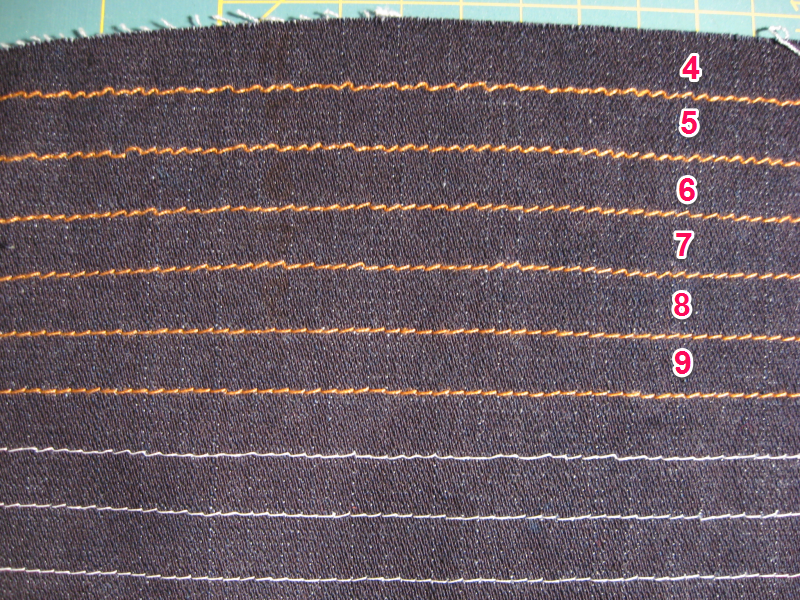Normal Tension Settings for Singer Fashion Mate
Before I started sewing my jeans together, the MPB Jeans Sew together-Along suggested to test needles, thread and fabric showtime. Especially since I am using some heavy cloth, and heavy topstitching thread.
Earlier I began test stitching, I consulted my sewing library for advice. Both the Reader's Digest Guide to Sewing and DK's The Sewing Volume were silent on the thing of thread tension. I did detect some help on adjusting tension in Nancy Zieman's Sewing A to Z, and in my sewing machine's instruction transmission. So if you demand to learn more about thread tension, your motorcar's instruction manual would be a great place to kickoff.
Sometimes when checking tension for sewing car and serger stitches, I find it useful to have a magnifying glass on hand to get a closer expect at the stitching. Y'all can come across how the top and bobbin threads wrap around each other, as well as how much the bobbin thread shows on the top side, and vice-versa.
Topstitching
For both seaming and topstitching on the jeans project, I am using a #100 denim needle. It'due south strong plenty to get through the fabric, and the eyelet is large enough to accommodate the heavy topstitching thread.
I am using #80 weight jeans topstitching thread from WAWAK Sewing and Tailoring Supplies (their house brand). I purchased v spools in different colors – red, olive greenish, navy blue, blackness, and for this project, "Levi Gold."

The top tension punch on my machine is numbered from 0 (loose) through ix (tight). The nominal setting is supposed to be 4. I did a serial of test stitches starting at 4, and going up by one number each time. The MPB Sew-Along suggested that a higher top tension would be necessary, to assistance pull the bobbin thread up through the heavy cloth. Also, the heavy thread will naturally increase the bobbin thread tension. (I didn't effort adjusting the bobbin thread tension, because information technology's a teeny tiny screw with no markings and I'm afraid I volition screw it up.)
I started with "normal" setting of 4, each row of stitching bumping one number higher.
Topstitching, top thread view. Numbers are tension settings for that line of stitching.

Topstitching, bobbin thread view. Annotation how the bobbin sew together neatens as peak thread tension increases.
Comparing the top thread and the bobbin thread, we see in that location are some pretty massive differences at the lower tension settings. At iv, the top stitch looks okay, but the bobbin side has all kinds of loose, unsightly loops. As the top tension goes up, the bobbin stitches look tighter and tighter, until at about 8 they more or less match the top stitching. I suspect the best setting is the highest i that gets the stitches on both sides to match, without beingness so tight the top stitches endure or the cloth starts puckering. And then 8 is the setting I'll be going with when working with the topstitching thread.
Regular Thread testing
I also use the #100 denim needle for regular seaming. I'one thousand using Gutermann all-purpose thread, in navy bluish to match the denim. (For the exam, I used white to contrast the denim).
Again, I started out with the "normal" setting of 4, and sewed each row one tension number higher.

Regular thread, summit thread view. Tension is ideal up to 6, just is also loftier after that and pulls the height stitch into a flat line.

Regular thread, bobbin thread view. The bobbin stitches clear up effectually six simply don't amend much after that.
Here, the bottom and top stitches match each other best with the tension set to half-dozen. To a higher place that, the top stitches offset to suffer – the tension is and so high, they pull up all the bobbin thread, lose their shape, and expect like a flat line. And then I will use 6 with the regular thread.
Other notes
I oasis't experimented much with more "regular" needle and cloth combinations, say an 80 needle with all-purpose thread on some cotton shirting. But I practice suspect the tension settings on my machine might be slightly out of adjustment, for instance a setting closer to "v" behaves a like "4" should. So if you're following forth, and specially if you have the same machine I do, yous should do your own ready of exam stitches to determine the best tension setting for your project.
0 Response to "Normal Tension Settings for Singer Fashion Mate"
Post a Comment